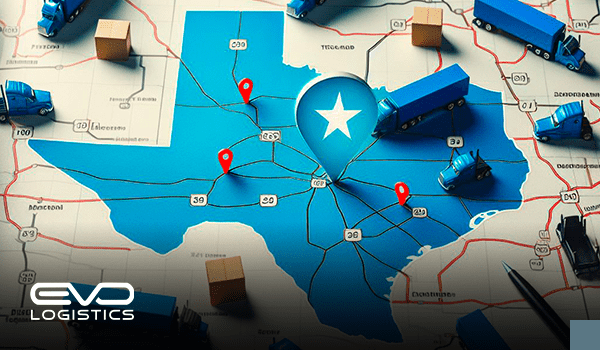The Future of Cold Storage in Texas

The future of cold storage in Texas is an exciting topic, given the state’s significant role in agriculture and commerce. As the demand for perishable goods continues to rise, so does the need for advanced cold storage solutions. This article delves into the innovations, challenges, and potential of the cold storage industry in Texas, offering a comprehensive view of what lies ahead.
Introduction

Emerging Technologies in Cold Storage
One of the most significant drivers of change in the cold storage industry is technology. Innovations such as automation, the Internet of Things (IoT), and artificial intelligence (AI) are revolutionizing how cold storage facilities operate. Automated storage and retrieval systems (AS/RS) are becoming increasingly common, allowing for more efficient and precise handling of goods.
IoT and AI Integration: The integration of IoT and AI in cold storage facilities enables real-time monitoring and control of temperature, humidity, and other critical factors. These technologies help prevent spoilage, reduce energy consumption, and optimize inventory management.
Advanced Refrigeration Systems: New refrigeration technologies, including transcritical CO2 systems and ammonia-based refrigeration, are gaining traction. These systems are not only more energy-efficient but also environmentally friendly, reducing the carbon footprint of cold storage operations.
Sustainability in Cold Storage
Sustainability is a key concern for the cold storage industry, particularly in Texas, where environmental considerations are increasingly important. Efforts to reduce energy consumption and minimize environmental impact are driving the adoption of green technologies.
Energy-Efficient Practices: Implementing energy-efficient practices, such as using LED lighting, improving insulation, and optimizing refrigeration cycles, can significantly reduce energy consumption in cold storage facilities.
Renewable Energy Sources: The use of renewable energy sources, such as solar and wind power, is becoming more prevalent in cold storage operations. These sources provide a sustainable alternative to traditional energy, helping to lower greenhouse gas emissions.
Market Trends and Consumer Demands
The cold storage industry in Texas is shaped by various market trends and consumer demands. The rise of e-commerce and the increasing demand for fresh and frozen foods are key factors influencing the industry.
E-Commerce and Cold Storage: The growth of e-commerce, particularly in the food and beverage sector, has led to increased demand for cold storage facilities. Consumers expect quick and efficient delivery of perishable goods, driving the need for advanced cold storage solutions.
Health and Wellness Trends: Consumer preferences are shifting towards healthier and fresher food options. This trend is driving demand for cold storage facilities that can maintain the quality and safety of perishable products.
The Role of Texas in Cold Storage
Texas plays a crucial role in the cold storage industry due to its size, agricultural output, and strategic location. The state’s diverse climate and expansive agricultural sector make it a hub for cold storage activities.
Agricultural Production: Texas is a leading producer of various agricultural products, including fruits, vegetables, and meat. Cold storage facilities are essential for preserving these products and ensuring they reach consumers in optimal condition.
Transportation and Logistics: Texas’ central location and extensive transportation network make it a key player in the logistics and distribution of perishable goods. Cold storage facilities in Texas serve not only local markets but also national and international destinations.
Challenges Facing the Cold Storage Industry
Despite the promising future, the cold storage industry in Texas faces several challenges. These include infrastructure limitations, regulatory requirements, and the need for skilled labor.
Infrastructure Development: The development of infrastructure to support the growing demand for cold storage is a significant challenge. Investment in new facilities and the modernization of existing ones are crucial to meeting future needs.
Regulatory Compliance: The cold storage industry is subject to stringent regulatory requirements to ensure food safety and quality. Compliance with these regulations can be complex and costly, requiring continuous investment in technology and training.
Skilled Workforce: The operation of advanced cold storage facilities requires a skilled workforce. Training and retaining employees with the necessary expertise is a critical challenge for the industry.
Innovations in Cold Chain Logistics
Innovations in cold chain logistics are crucial for the efficient transportation of perishable goods. Technologies such as blockchain, advanced tracking systems, and temperature-controlled packaging are enhancing the reliability and transparency of cold chain logistics.
Blockchain for Transparency: Blockchain technology is being used to enhance transparency and traceability in the cold chain. By providing a secure and immutable record of the entire supply chain, blockchain helps ensure the integrity and safety of perishable goods.
Advanced Tracking Systems: Modern tracking systems enable real-time monitoring of shipments, ensuring that temperature and humidity levels are maintained throughout the supply chain. This reduces the risk of spoilage and improves overall efficiency.
Temperature-Controlled Packaging: Innovations in packaging, such as phase-change materials and vacuum insulation panels, are improving the thermal performance of temperature-controlled packaging. These advancements help maintain the quality of perishable goods during transit.
The Future Outlook for Cold Storage in Texas
The future of cold storage in Texas looks promising, with continued growth and innovation on the horizon. The adoption of advanced technologies, coupled with a focus on sustainability and efficiency, will drive the industry forward.
Expansion and Modernization: As demand for cold storage continues to rise, expansion and modernization of facilities will be necessary. This includes the construction of new facilities and the upgrading of existing ones to incorporate the latest technologies.
Collaboration and Partnerships: Collaboration between industry stakeholders, including cold storage operators, technology providers, and regulatory bodies, will be crucial for addressing challenges and driving innovation.
Research and Development: Continued investment in research and development will be essential for advancing cold storage technologies and practices. This includes exploring new refrigeration methods, energy-efficient solutions, and sustainable practices.
The Importance of Cold Storage in the Texas Economy
Cold storage is a vital component of the Texas economy, supporting the agricultural, food, and logistics sectors. The industry’s growth and development have far-reaching implications for economic stability and food security in the state.
Economic Impact: The cold storage industry contributes significantly to the Texas economy by supporting agricultural production, creating jobs, and facilitating trade. The industry’s expansion will continue to drive economic growth and development.
Food Security: Cold storage facilities play a critical role in ensuring food security by preserving the quality and safety of perishable goods. This is particularly important in Texas, where agriculture is a key economic driver.
Conclusion
The future of cold storage in Texas is bright, with numerous opportunities for growth and innovation. By embracing advanced technologies, focusing on sustainability, and addressing industry challenges, Texas can continue to lead in the cold storage sector. As the demand for perishable goods rises, the cold storage industry will play an increasingly important role in supporting the state’s economy and ensuring food security.
FAQs
What are the latest technologies in cold storage?
The latest technologies in cold storage include automated storage and retrieval systems (AS/RS), IoT integration, AI-driven monitoring, advanced refrigeration systems, and blockchain for supply chain transparency.
How does Texas benefit from cold storage facilities?
Texas benefits from cold storage facilities by supporting its agricultural sector, ensuring food safety and quality, facilitating trade, and contributing to economic growth.
What are the challenges in the cold storage industry?
Challenges in the cold storage industry include infrastructure development, regulatory compliance, skilled workforce shortages, and the need for continuous investment in technology.
How is sustainability being addressed in cold storage?
Sustainability in cold storage is being addressed through energy-efficient practices, the use of renewable energy sources, and the adoption of environmentally friendly refrigeration systems.
Why is cold storage important for food security?
Cold storage is important for food security because it preserves the quality and safety of perishable goods, reducing spoilage and waste, and ensuring a steady supply of fresh and frozen foods.
What is the future outlook for the cold storage industry in Texas?
The future outlook for the cold storage industry in Texas is positive, with continued growth driven by technological advancements, increased demand for perishable goods, and a focus on sustainability.


